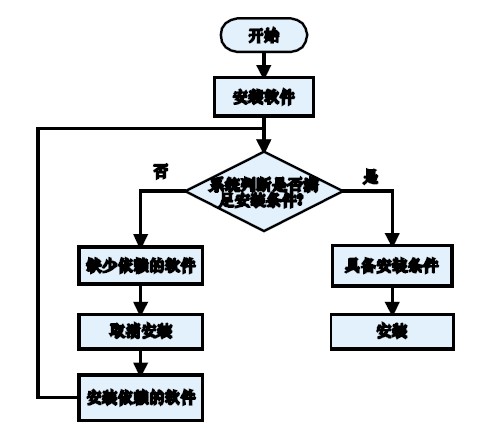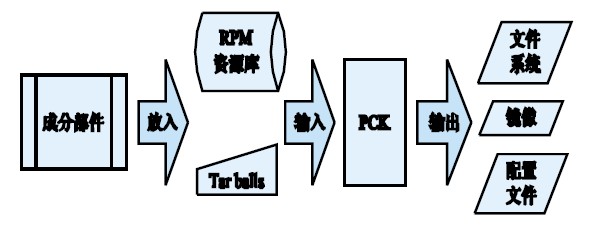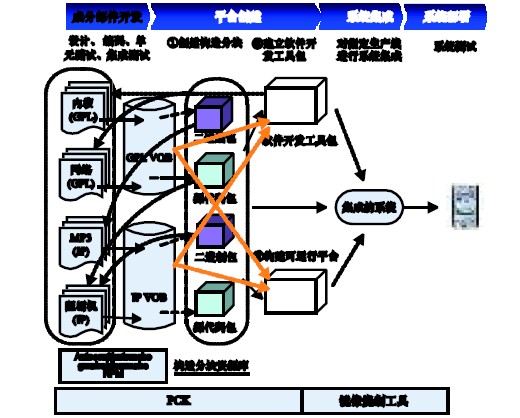Abstract: With the rich functions of mobile phones and the expansion of the field of use, mobile phone software platform technology has been paid more and more attention. The impact of the mobile phone software platform on mobile phone development and mobile phone performance has made it a research hotspot in the technical field. In order to make the establishment, integration and distribution of Linux- based embedded software platforms easier, a mobile phone software platform creation tool is needed to improve the development efficiency of the mobile software platform. The mobile software platform creation tool is a graphical user interface system integration and distribution tool that covers the entire process of creating a mobile software platform. The advantages of Linux-based mobile phone software platform are analyzed, the software package management method is discussed, the system structure and related technologies of platform creation tool are described, and the important role of the tool in mobile phone software development process is discussed.
This article refers to the address: http://
1 Introduction
With the rapid development of mobile phone functions, more and more software functions on mobile phones have been very similar to those on personal computers. Therefore, mobile phones also need a more powerful operating system as a support.
The mobile phone software platform based on the Linux operating system has been considered as the next generation mobile phone software platform.
At present, many mobile phone developers have begun to adopt mobile phone software platforms. However, the mobile phone software platform requires a lot of time, manpower and financial resources to create while providing a reliable mobile operating system and high-quality software. The original mobile phone software platform development method is not only inefficient, but also requires a high level of technical skills for developers. It requires a lot of training to be competent, which will inevitably increase the development cost of the product. Mobile phone developers are looking for a more convenient and efficient way to create their own next-generation mobile software platform.
2 Linux-based mobile phone software platform
Personal computers have a wealth of features because they have an operating system and software running on top of the operating system. Similarly, mobile phones are offering a rich set of features that require a powerful operating system and software to support them. Compared to other operating systems, the use of an open source Linux operating system as a mobile operating system can significantly reduce handset development costs. Another advantage of open source is that it allows mobile phone manufacturers to develop a Linux operating system suitable for their mobile phones according to the actual situation, so that they can make their products unique, avoid being subject to people, and satisfy users in many aspects. Application requirements.
The concept of a mobile software platform can be summarized as:
(1) The mobile phone software platform is based on a certain hardware architecture. The specific software platform can only be used for the hardware system of a specific vendor; (2) the mobile software platform provides basic support for the application; (3) the mobile software platform With some applications; (4) mobile software platform can be easily extended, mobile software developers can easily create new functions on the platform, which is one of the most important functions.
The mobile phone software platform architecture is integrated on the mobile operating system and integrated with different operating systems through an abstraction layer. A complete software platform mainly includes middleware, system abstraction layer, key application software and SDK (Software Developers Kit) development environment. The software platform cannot replace the operating system. However, as far as application software is concerned, it can be directly developed on the software platform, which is also an important application of the mobile phone software platform.
The competition among mobile phone manufacturers is becoming more and more fierce, and new products are emerging one after another. Faced with new market requirements, as long as they are expanded on existing platforms, new mobile phone products can be launched soon, gaining an advantage in the competition.
3 platform creation tool development background
3.1 Development status of mobile phone software platform
The entire development process of the mobile phone is shown in Figure 1, where the development of mobile phone software includes the creation of a platform and product development.

Figure 1 mobile phone development process
Creating a mobile phone software platform is a huge project. Many functional components need to be built. Each functional component exists independently, but complements each other. It requires multiple parties to work together. The whole process takes a long time.
The actual situation of doing a full build is that it takes more than 3 hours to complete a full build of a feature. The developer can only proceed to the next step after waiting for the build to complete. In the ideal case, the build was successful after 3 hours and the test passed. However, in general, due to the source code problem, the build often fails halfway through the process, and the source code needs to be modified to rebuild. Even if the build is successful, if you find a problem during the test, you need to modify the code and then rebuild it, and then repeat it several times. For inexperienced developers, or in the early stages of a feature development, the frequency of this rebuild will be greatly increased, which will waste a lot of effort and work efficiency will drop significantly. Any modification of a functional component will affect the entire platform, and the entire platform needs to be re-constructed. In the face of increasingly competitive markets, this will increase product development costs and increase development cycles.
The core of future mobile phone product competition is the software platform, and will become the final competitive field of some big mobile phone brands. As a free open source system, the Linux mobile phone software platform is particularly prominent in reducing the R&D costs of mobile phone manufacturers, improving the response time of new products, and realizing product personalized design. The Linux mobile phone software platform has become the next generation mobile phone software platform recognized by many senior experts and mobile phone manufacturers, and has broad development prospects.
3.2 RPM package management.
One way to solve the status quo is to use package management. The package management system consists of a number of files including programs, data, documents, and configuration information, which are stored in a special format file-package file. Package-based system integration and distribution has been widely used in contemporary Linux distributions. The two most popular package management methods are Red Hat's RPM (Red Hat Package Manager) and Debian's dpkg.
RPM package management is a development package system that anyone can use. For end users, RPM provides a lot of features that make software maintenance much easier than before. The RPM package can be installed, uninstalled, and upgraded with a short command, and all the messy details are processed. RPM maintains a database of installed packages and files, and can use powerful query and verification functions on the system [1]. An application in an RPM package, sometimes in addition to its own attached files to ensure its normal In addition to running, other specific versions of the file are required as support, which is the dependency of the package [2].
After using the RPM management software, the software installation process is shown in Figure 2.

Figure 2 Software installation flow diagram using RPM.
4 platform creation tool development background
After more than a decade of development, Linux-based development is no longer the first time to build everything. In the desktop space, Linux has become a development system with mature software building blocks and comprehensive tools. However, in the embedded world, there are still some gaps in the Linux operating system in transforming the traditional raw data-driven development model into a new package-based development model.
The main problem with the original data-driven development model is that it does not have an effective way to control the boundaries between features, which causes the dependency between the feature code to exceed the API (Application Programming Interface) and ultimately the entire platform feature. The relationship between them has become more complicated. These complex features will be stacked in the platform source code, making future identification and modification more difficult. After years of development, the entire software platform will be difficult to expand, tailor and customize to meet the needs of product changes.
As mobile phone manufacturers have confirmed Linux as the next-generation mobile software platform, the development of Linux-based mobile phone product features will become a mainstream. In order for development to be realized, a reasonable integrated development environment, including a complete set of development processes and development tools, is needed to customize and distribute a complete software platform.
While traditional source code-based system integration can still meet demand, the accumulated engineering experience tends to be based on software-based system integration and deployment scenarios, as package-based solutions have proven to be more reliable, flexible, and secure. It is foreseeable that software-based system integration solutions will take advantage of platform integration and distribution.
Linux enterprise solution providers are trying to narrow the gap in the embedded world of Linux operating systems. However, the package format submitted by the Linux Enterprise Solution can only be fully effective if the infrastructure is suitable for development. The mobile software platform creation tool is an RPM-based platform to build, manage, and deploy system tools, and also provides strong support for the release of embedded systems. Figure 3 illustrates the platform creation tool based on the working mode of the RPM package.

Figure 3 RPM-based software build and release.
In an RPM-based solution, developers only need to be aware of the source code of their own packages. VOB.VOB is a repository that stores project products and data in versions. All dependent packages are stored on the RPM issuer combined with the RPM VOB, which is maintained by the software configuration administrator. The feature developer gets the binary RPM package from the release server and installs the build environment with the help of the platform creation tool. When development goes to a certain level and needs to be delivered, the developer will make a build request. The configuration administrator will process the build request and build the package that the request is built with the packages it depends on. After that, use the platform creation tool to release the version through the RPM VOB and the release server. This way, developers can use the new version for enhanced development. Managers and other project stakeholders can use a web browser to view release processes and platform changes.
When the RPM package published by the configuration administrator is not available, developers can also use the platform creation tool to adjust these packages to resolve interdependencies.
The above development of the infrastructure has enhanced the boundaries between the features and access to the API by using the distribution package of the feature. Therefore, they will not see their complexity through the dependencies between features, ensuring that the mobile software platform is scalable and adaptable.
The platform creation tool is to become a system tool for building, managing, and deploying an RPM-based platform, and to provide strong support for the release of embedded systems.
5 Design goals for platform creation tools
Mobile phone software platform creation tools need to focus on two issues:
One is to ensure that the results built using the tools are correct. Using tools can improve development efficiency and shorten training time for developers, but the most important thing is to ensure that the final image generation is correct; the second is to make full use of the already generated mobile phone RootFS and image. In the development process of the mobile phone, it will undergo numerous builds, tests, and mirrors. Every time you find a problem and modify the source code, you need to do it again, but in reality, there are not many changes. If you make full use of the past foundation, you can save a lot of time.
The platform creation tool should maintain a workspace for users to build, architect, and distribute package-based platforms. This workspace should be a separate space for maintaining current engineering data and structures for unique users. Based on this workspace, the platform creation tool should mainly support the following features:
(1) Support package management operations, such as: installation, uninstallation, upgrade, downgrade, information query, etc.; (2) support platform construction of source code RPM package, source code directory and binary RPM; (3) support based on The user-specified RPM package generates the mobile phone RootFS; (4) supports the generation of image files according to specific system partitioning, RootFS content and RootFS type; (5) calls the image burning tool to burn the image to the target device; (6) support Platform customization and export of backup files for future use; (7) Support for software development kits based on specified RPM packages and RPM development packages. The files for the runtime libraries, toolchains, header files, and software development kits are provided by the user's RPM development package; (8) Provide plug-in mechanisms to make new targets and toolchains available.
6 The role of the platform creation tool
The platform creation tool is positioned as a graphical user interface system integration and distribution tool to help developers develop embedded programs that make the creation, integration, and distribution of Linux-based embedded software platforms easier. Its highlights are flexible package management mechanism, convenient platform construction and deployment, support for different production lines, and rapid generation of software development kits, etc., which are easy to use, high in work efficiency, and highly reusable. The most important thing is to greatly improve the development efficiency, and enable developers and platform configuration managers to get rid of complex command-line operations and complete the work through a clear and clear GUI. The workflow is shown in Figure 4.

Figure 4 Platform creation tool workflow.
Specifically, it is aimed at the integration and distribution of the Linux-Java mobile phone software platform, replacing the complicated overall construction method with the software package management method; and replacing the manual command line operation mode in an automatic execution manner to improve the efficiency of creating the mobile phone software platform. And make the created mobile software platform have higher quality and better maintainability.
The development of mobile phone software platform can be divided into four parts: component component development, platform creation, system integration and system deployment, as shown in Figure 5.

Figure 5 Linux/Java platform construction model.
It can be seen that the use of platform creation tools almost completely reflects the entire process of platform construction. In the development stage of the component parts, each component component that has been developed is packaged separately using RPM, and then managed by the platform creation tool. In the platform creation phase, the platform creation tool is used to block the software packages, and each resource group is divided into different resources according to different classifications, and a software platform can be built to build a software development toolkit. At this time, the software platform required for the mobile phone software product of the designated production line has been successfully established, the platform has all the required software configurations, and an image file can be generated. Finally, using the image burning tool, the generated image is burned to the phone, and the system can be tested.
7 Conclusion
Using the platform creation tool based on the package management method can not only make up for the deficiencies of the original development method, but also automatically provide the correct configuration for the product, making it easier to track the dependencies between the packages and to release, install, uninstall, and upgrade the software. It is also the most widely accepted method of publishing source code to open source software organizations, making it easy to confirm the flexibility of open source software.
The Mobile Software Platform Creation Tool is a graphical user interface system integration and distribution tool that helps developers develop embedded programs that make it easier to build, integrate, and distribute Linux-based embedded software platforms. The use of platform creation tools will enable mobile phone developers to develop a more complete mobile phone software platform while reducing development costs, and ultimately provide users with more feature-rich mobile phone products.
DMX512 Digital LED Strip is a programmable led strip, be controlled by the international standard DMX512 protocol, which is addressable and programmable
by using the external drive chip DMX512.Compatible with and extend DMX512 (1990) signal protocol, the control mode is differential parallel,
built-in 485 decoding module, strong anti-interference ability, low-voltage DC24V,very safer for users.
Supports the operation mode of first installing and writing code later, and can realize any animation effect of the product through controller programming.
Suitable for large engineering projects.
DMX512 Digital LED Strip
High CRI LED Strip,Outdoor LED Strip Light,DMX RGB LED Strip,DMX512 Digital LED Strip
SHEN ZHEN SEL LIGHTING CO.,LTD , https://www.sellighting.com
![<?echo $_SERVER['SERVER_NAME'];?>](/template/twentyseventeen/skin/images/header.jpg)